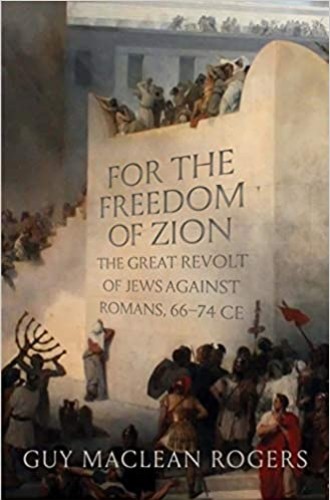How the Jerusalem temple fell
Josephus was tight with the emperor. Guy MacLean Rogers trusts his account anyway.
Woe to you, O Jerusalem—and woe to the historian who writes about your fall to the Romans! The enterprise, undertaken by Guy MacLean Rogers, is woeful because our knowledge of the great Jewish revolt and the subsequent siege and destruction of Jerusalem comes almost exclusively from the prolific but troublesome Josephus. A perusal of Rogers’s endnotes betrays his heavy reliance on Josephus, accounting for maybe 80 percent of his citations. Josephus wrote about the war while comfortably ensconced in Rome, where he dined with the emperor. The emperor had given Josephus expensive land in Judaea and had exempted that land from the onerous taxes that all other Jews had to pay. Josephus and the emperor were tight.
By the time he wrote of the war, Josephus had come under increasing criticism for his involvement. According to his own accounts, he had tried to dissuade the rebels from their growing insurgency before taking a military post in Iotapata in 67 CE. As the Romans were breaching that city’s walls, Josephus famously entered into a suicide pact with his comrades—but then reneged at the last minute and threw himself on the mercy of his enemies. The Romans saw merit in keeping Josephus alive, and the Jewish general became a Roman asset from that day onward.
As might be expected, in the years following the fall of Jerusalem, some of Josephus’s fellow Jews—among the few who were left alive—looked unfavorably upon his betrayal. He wrote The Jewish War, his Life, and On the Antiquity of the Jews as histories, but also as apologias for his own actions. It was God, he said, who told him to side with the Romans. And it was also God who granted the Romans victory, he asserted, because of the unfaithfulness of the Jews.
This is why Josephus has been a contentious source for the events in Jerusalem between 66 and 74 CE since his own lifetime. And yet, in one of several dubious editorial decisions, we do not read Rogers’s evaluation of the reliability of Josephus until page 469, in the book’s first appendix.
For the first 430 pages, Rogers tells the story of the fall of Jerusalem in painstaking detail, sometimes resorting to paragraphs like this:
In the first year of Nero’s reign (54 CE), Azizus, the ruler of Emesa (Homs in modern Syria), died and was succeeded by his brother C. Iulius Sohaemus. Nero then placed the government of Armenia Minor in the hands of Aristobulus, son of Herod, the king of Chalcis. In 54–55 or 55–56 Agrippa II then was given a part of the Galilee, the polis of Tiberias and the large village and toparchy capital of Tarichaeae (Magdala/Migdal), the poleis of Abila (Tel Abil in Jordan) and Iulias in the Peraea, and the 14 surrounding villages.
Whether it was first said by Mark Twain, Arnold Toynbee, or someone else, the maxim holds that history is “simply one damned thing after another.” The trick in writing compelling history is not to fall into the trap of recounting each damned thing until your reader is pummeled into submission. And one of the ways to avoid this is to alternate between the granular and the circumspect, to regularly rise above the mundane and give the reader perspective, to make evaluations and judgments, to provide a narrative arc. Unfortunately, Rogers rarely does this. Instead he powers through each damned thing, reserving his opinions for the final section of the book. I am happy to report that those final 70 pages are rewarding. But it’s a long road to get there.
Rogers is less harsh in his criticism of Josephus than others have been, finding the scribe relatively trustworthy. Indeed, Rogers agrees with Josephus that the Jews of Jerusalem could have—and should have—avoided a confrontation with Rome. Most Jews agreed with Josephus: they may not have loved Roman rule, but it was better than the alternative.
The Zealots, however, like all political revolutionaries, despised the status quo. They drove many peace-loving Jews from the city, and when the Idumaeans entered the city and joined them—an alliance that the Idumaeans immediately regretted—that was enough to tip the balance to war.
Within the walls of the city, various factions of Jews argued and fought, sealing their own fate, according to Josephus (and Rogers). For example, the Zealots destroyed the city’s grain stores, fearing that the Romans would get to them. This act led to the starvation of thousands. Josephus himself often stood at the base of the walls and shouted up to his coreligionists in their native tongue (whether Hebrew or Aramaic is unknown), begging them to surrender before they were destroyed. What the Jews lacked was a titular leader.
In their first attempt to quell the revolt, the Roman forces also had a less-than-competent leader named Cestius, and they were routed in the autumn of 66 CE. But the Romans always learned from their military mistakes, and the successive generals, Vespasian and Titus, were more deliberate and careful in their siege of the holy city. Indeed, their successes in Judaea propelled each of them to the imperial purple. Their family, the Flavians, held a long reign that resulted, among other things, in the construction of the
Colosseum.
As with so much ancient history, the numbers astound: 3,000 died this day, 20,000 that day. Tens of thousands were thrown over—or leaped over—the walls into ravines. It was nothing short of apocalyptic. Honestly, it’s something of a miracle that the Jewish people survived. In the end, Jerusalem was razed, along with the temple, and the Jewish sacrificial cult was snuffed out. A new Judaism, rabbinic Judaism, was born out of the ashes.
Three other scribes were paying close attention, too. They also saw something epochal in the fall of the temple, something that their apocalyptic rabbi had preached about. We know those scribes as Mark, Matthew, and Luke.






